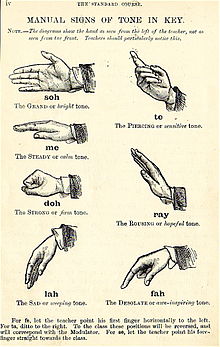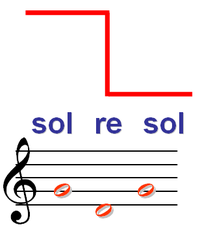|
Solresol
Solresol (Solfège: Sol-Re-Sol), originally called Langue universelle and then Langue musicale universelle, is a musical constructed language devised by François Sudre, beginning in 1817. His major book on it, Langue Musicale Universelle, was published after his death in 1866,[1] though he had already been publicizing it for some years. Solresol enjoyed a brief spell of popularity, reaching its pinnacle with Boleslas Gajewski's 1902 publication of Grammaire du Solresol. Today, there exist small communities of Solresol enthusiasts scattered across the world.[2] Sudre or GajewskiThere are multiple versions of Solresol, and they each have minor differences. Currently, there are three small variations on the language, each of which mostly edit vocabulary and a small amount of the grammar. Sudre created the language, and thus his version deserves the title of being the original version of Solresol. Vincent Gajewski popularised the language as the president of the Central Committee for the study and advancement of Solresol, founded by Madame Sudre. Boleslas Gajewski, the son of Vincent, published the Grammar of Solresol.[3] This is the most publicised version of Solresol, thanks to the translation to English by Stephen L. Rice from 1997,[3][4] with a chunk of the vocabulary changed from the original, as well as some of the grammar. One example is the word fasol, defined as "here" in Sudre's dictionary, but "why?" in Gajewski's. The third is an unofficial version developed over time by the community, dubbed "Modern Solresol". It uses Sudre's version as a base, with tweaks to the grammar and vocabulary, such as changing the definitions of sisol and sila from meaning "Sir" and "Young man", to an honorifics system inspired by what is used in Japanese; both are gender-neutral titles, one to be respectful, and one to be affectionate.[5] Gajewski's publication brought various additions that don't conflict with the original version of the language, such as various new methods of communication, including a set of symbols, using the seven colours of the rainbow, using tonic sol-fa to sign the language, and more.[3]: 16 Phonology Solresol can be communicated by using any seven distinct items, with a maximum of five per word. The main method of communication is by using the seven solfège syllables (a form of solmization), which may be accented, lengthened or repeated. The simplest way to use these syllables is to speak them as if they were regular syllables. Due to predating the IPA, there are no specific pronunciation rules beyond the standard readings of the solfège. Due to each syllable being fairly distinct, they may be pronounced in almost any way the reader prefers. Although the seventh note is more modernly pronounced as "Ti" in a lot of countries, "Si" is still generally preferred within the Solresol community.[citation needed] Sudre outlined a way of transcribing the phonetics of French (and thus many other languages) into Solresol, primarily used for proper nouns.[1]: 32 Using common pronunciations as given by the likes of Wiktionary, it is possible to reconstruct a table of sounds using the modern IPA. Due to the paucity of syllables, it is necessary to leave a brief pause between words so that each word remains clearly separate. As noted by Boleslas Gajewski: "one should take great care to pause after every word; this slight pause is necessary to separate the words, so that the listener does not become confused".[4]: Reversed meanings VocabularyIn Solresol morphology, each word is divided into categories of either meaning or function, where longer words are generally more specific. Words are differentiated by three main characteristics: the initial syllable, word length, and whether it has a pair of repeated syllables. Words of syllable length 1 and 2 are used for pronouns and common particles, and those with repeated syllables are tenses. Words of syllable length 3 are devoted to words used frequently (at the time of Solresol's creation). The ones which include repeating syllables are reserved for "numbers, the months of the year, the days of the week, and temperature [weather conditions]", e.g. redodo "one", remimi "two" (according to Gajewski). Words of syllable length 4 fall into various themed categories. For example, words beginning with 'sol', which include no repeating syllables, have meanings related to arts or sciences (e.g. soldoredo, "art"; solmiredo, "acoustic").[1]: 22.V However, if words of syllable length 4 have a pair of repeated syllables, their meanings relate to sickness or medicine (e.g. solsolredo, "migraine"; solreresol, "smallpox").[1]: 23.VI More specifically, the classes without repeating syllables, are: 1. 'do': man, his body and spirit, intellectual faculties, qualities and nourishment; 2. 're': clothing, the house, housekeeping and the family 3. 'mi': man's actions and his flaws 4. 'fa': the countryside, travel, war, the sea 5. 'sol': fine arts and sciences 6. 'la': industry and commerce 7. 'si': the city, government and administration With repeating syllables, the same syllables yield: 1. 'do': religion 2. 're': construction and various trades 3. 'mi': prepositions, adverbial phrases and isolated adverbs 4. 'fa': sickness 5. 'sol': sickness (cont.) 6. 'la': industry and commerce (as in the non-repeating type) 7. 'si': justice, the magistracy, and the courts Finally, combinations of five syllables designate animals, plants and minerals. By default, all animate nouns and pronouns imply that they are of male sex. To differentiate the female sex, a bar, hyphen or macron is added to the final syllable of the corresponding article or the word itself. In speech, this is indicated by repeating the vowel of the syllable, with a glottal stop separating the repeated vowel from the rest of the word.[1]: 24 However, in modern translations, pronouns do not change depending on gender. Instead, they are simply translated into English as neutral pronouns; it and they. A unique feature of Solresol is that meanings can be inverted by reversing the syllables in words. For instance fala means good or tasty, and lafa means bad. Interruptions in the logical order of words in each category are usually caused by these reversible words.[1]: 31.XXI However, not all words are reversible in this sense, such as dorefare meaning neck, and refaredo meaning wardrobe, which are obviously not opposites. The following table shows the words of up to two syllables from Gajewski's dictionary:
The definite article has different forms for nominative, genitive and dative case, or, in other words, for "the", "to the", and "of the": 'la', 'fa' and 'la si', respectively.[1]: 23-24.VII-VIII GrammarApart from stress and length, Solresol words are not inflected. To keep sentences clear, especially with the possibility of information loss while communicating, certain parts of speech follow a strict word order.
To make a word plural, an acute accent is added above the last syllable, which in speech is pronounced by lengthening the last letter of said syllable.[1]: 24.IX Examples of how to mark plural masculine and feminine words:
This only affects the first word in a noun phrase. That is, it only affects a noun when the noun is alone, as above. If the word is accompanied by a grammatical particle (la, fa or lasi), the particle will take the gender and or number marking instead:
Parts of speech (as well as more specific definitions for certain words) are derived from verbs by placing a circumflex above one of the syllables in writing, and by pronouncing said syllable with rinforzando (sudden emphasis or crescendo). With the accent placed on the first syllable, the word becomes a noun. In four-syllable words, accentuating the second syllable creates an agent noun. The penultimate syllable produces an adjective, and the last creates an adverb.[1]: 25.XI For example,
On computers using keyboard layouts without the circumflex accent, the syllable may either be printed using capital letters, or a caret placed between letters of a syllable or after a syllable. Due to the grammar and word order of Solresol, distinguishing parts of speech aren't usually required to understand the sentence. The various tense-and-mood particles are the double syllables, as given in vocabulary above. In addition, according to Gajewski, passive verbs are formed with faremi between this particle and the verb. The subjunctive is formed with mire before the pronoun. The negative do only appears once in the clause, before the word it negates. The word fasi before a noun or adjective is augmentative; after it is superlative. Sifa is the opposite (diminutive):[1]: 21.III
QuestionsQuestions in Solresol are not given much attention in the original documentation, nor do they have many examples. Sudre's publication includes three examples of interrogative sentences:[1]: 127
To make this an affirmative statement, you add the personal pronoun afterwards:
Gajewski instead places the subject of the sentence after the verb instead of before the verb, a construction common in European languages. Some examples are:[4]: Interrogation and Negation
In all versions of the language, there are words in the 4-syllable, repeated "Mi" section of the dictionary which includes some common questions, such as:[1]: 109.123
Methods of communicationSymbolsEach "note" of Solresol is represented as a symbol, for example, "Do" is a circle.  Words of Solresol are formed by connecting the symbols in the order they appear in the word. Double notes are represented by crossing the symbol.  Further attributes
Using the tonic sol-fa system by John Curwen, SolReSol can also be signed. Further developmentsAnother way of using Solresol is called ses, and was developed by George Boeree.[citation needed] The notes are given a representative consonant and vowel (or diphthong). The most basic words use the vowel alone; all others use more complex syllable structure.
In this way, one can write or pronounce words such as this one:
Because the plural and feminine forms of words in Solresol are indicated by stress or length of sounds, ses uses pau (some) or fai (many) to indicate the plural, and mu (well) to indicate the feminine when necessary. EncodingAn ISO 639-3 language code had been requested on 28 July 2017,[6] but was rejected on 1 February 2018.[7] Solresol has been assigned the codes The seven basic symbols have been proposed to be registered in the ConScript Unicode Registry.[9] Example textArticle 1 of the Universal Declaration of Human Rights in Solresol:
Article 1 of the Universal Declaration of Human Rights in ses:
Article 1 of the Universal Declaration of Human Rights in English:
See alsoReferences
External linksWikimedia Commons has media related to Solresol.
|
||||||||||||||||||||||||||||||||||||||||||||||||||||||||||||||||||||||||||||||||||||||||||||||||||||||||||
